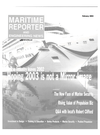
Page 15: of Maritime Reporter Magazine (February 2003)
Read this page in Pdf, Flash or Html5 edition of February 2003 Maritime Reporter Magazine
be prepared by the Secretary for deter- ring and responding to a transportation security incident. Further, it must be consistent with the Area Maritime
Transportation Security Plan for each area within which it operates. The
Areas, for this purpose, are expected to align with the Captain of the Port (COTP) zones. The Coast Guard has disseminated neither the National nor the Area Maritime Transportation
Security Plan, although it has issued a
Navigation and Vessel Inspection
Circular (NVIC) providing guidance to field units related to preparation of port security plans. It is unclear how owners and operators will be expected to com- ply with the consistency requirement if the various national and area plans are not promulgated soon.
Qualified Individual
The plan must identify the qualified individual (QI) having full authority to implement security actions, and require immediate communications between that individual and the appropriate
Federal official (presumably the COTP) and the persons providing additional security. It is unclear what qualifica- tions will be expected of a QI. If it is similar to the standards utilized under the Oil Pollution Act of 1990 (OPA 90) for oil spill vessel response plans (VRPs), the individual will have to be based in the United States and be avail- able 24-hours a day.
Availability of Security Measures
The plan must also identify, and ensure by contract or other means approved by the Secretary, the availabil- ity of security measures necessary to deter to the maximum extent practicable a transportation security incident, or a substantial threat of such a security inci- dent. As with the QI, this clearly derives from OPA 90, but it is uncertain what security measures the Coast Guard envi- sions. It could be anything from a guard service posted at points of ingress and egress from the ship to divers searching the hull for limpet mines.
Security Incident Response Plan
Either as part of the vessel security plan or as a stand-alone document, the
Secretary must require each vessel to prepare and submit a security incident response plan. The plan is to provide a comprehensive response to an emer- gency, including notifying and coordi- nating with local, State, and Federal authorities, including the Director of the
Federal Emergency Management
Agency (FEMA), securing the vessel, and evacuating vessel personnel. The limited legislative history of this provi- sion indicates that Congress was con- cerned about response to such things as an oil spill from the vessel that might arise from a terrorist attack or other security incident. The Notice issued by the Coast Guard provides no indication of how the agency will interpret and implement this provision.
Deadlines and Implementation
The MTSA provides that the vessel security plan must be submitted to the
Coast Guard within six months after promulgation of the interim regulations.
The vessel for which a vessel security plan is required may not operate in U.S. waters one year after promulgation of the interim regulations unless it has an
Government Update approved plan and is operating in com- pliance therewith. Notwithstanding the 1-year restriction, the Secretary may authorize a vessel to operate without an approved security plan (for up to 1 year after submission of a security plan), if the owner or operator has certified that it has ensured by contract or other approved means the availability of secu-
Circle 241 on Reader Service Card
Diesel engines tailored to meet any requirement from 450 kW to more than 100.000 kW
February 2003 15

 14
14

 16
16
